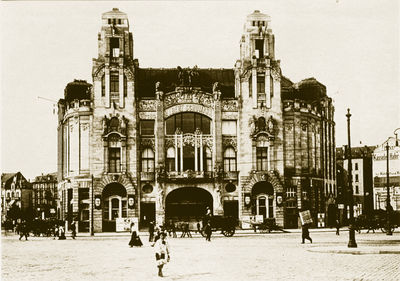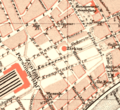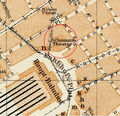Circus Schumann (Frankfurt)
From Circopedia
By Dominique Jando
The Circus-Theater Albert Schumann (also known as Circus Schumann, and later, Schumann Theater) stood in Frankfurt am Main, Germany, from 1905 to 1944. It was located opposite the Hauptbahnhof (the main train station), at the center of the city, occupying the block between Karlstrasse and Taunusstrasse. What had remained of the building after the massive Allied bombing of March 1944 was demolished in 1960, and an important part of Frankfurt’s rich cultural history went up in smoke with it.
The Circus-Theater Albert Schumann
The building had been established by the great German equestrian and circus director Albert Schumann (1858-1939), who had already taken over the old Circus Renz in Berlin, and had built another Circus Albert Schumann in Vienna. Schumann had originally erected a temporary wooden structure in 1893 in Frankfurt just two blocks east of the new circus's location, which was then situated in a largely undeveloped area; the success of the shows he gave there encouraged him to construct a permanent building in the same area.
To finance the project, Albert Schumann created a new company, the Aktiengesellschaft für Zirkus- und Theaterbau (Corporation for the Circus and Theater Building) based in Berlin and Frankfurt; among the shareholders were Schumann’s brother-in-law Julius Seeth (1863-1939), a celebrated wild animal trainer, and later to Seeth’s brother-in-law, British-born equestrian Joe Hodgini (Joseph Henry Hodges—1865-1950). The company asked the architects Friedrich Kristeller and Hugo Sonenthal to design a building that could be used indifferently as a circus or a variety theater. Kristeller was a Berlin-based architect, who would design a few years later a famous Art Nouveau office building on Krausenstrasse, which houses today the Federal Ministry of Transportation.The construction(French) A temporary circus building, originally made of wood and canvas, and later, of steel elements supporting a canvas top and wooden wall. Also known as a "semi-construction." began in September 1904, and the Circus-Theater Albert Schumann opened its doors on December 5, 1905. It was equipped with a ring and a stage (like most European circus buildings since Astley's), and the ring could be covered with seats to transform the circus into a full-fledged theater, with a stage equipped with all the latest technical amenities. At full seating capacity, the house could accommodate 4,500 spectators. The dome above the ring (or the parterre, according to the configuration) was 28 meters high (approximately 92 feet), which allowed all sorts of large aerial acts, and there were stables for 150 horses, located below the stage.
The monumental façade of white sandstone was designed in the then fashionable Art Nouveau (or Fin de Siècle) style, with elaborate ornamentation by the eminent Berlin sculptor, Joseph Uphues (1850-1911). The vast foyer was decorated with frescos by Frankfurt-born painter Alfred Helberger (1871-1946), who was to become one of Germany’s most prominent impressionist painters—until the Nazis banned his work, which they considered "degenerate." The front of the theater also housed a high-end restaurant, a popular café, and a bar, and a 150-meter long Beer Tunnel ran under the building (it would serve as a bomb shelter during WWII). The entire project had cost four million Marks (approximately US$ 16 million).
From Riches To Rags
Albert Schumann gave the initial management of his circus-theater to his brother-in-law and partner, Julius Seeth. Each season until WWI, the building offered one month of circus, one month of operetta, and ten months of variety. After the war, it became mostly a variety theater: Varieté shows—a mixture of circus acts, singers, dancers and comedians—were immensely popular in Germany in the 1920s and 1930s; great circus acts such as The Codonas on the flying trapezeAerial act in which an acrobat is propelled from a trapeze to a catcher, or to another trapeze. (See also: Short-distance Flying Trapeze), the legendary juggler Enrico Rastelli, and the greatest clowns of the era, Grock, The Fratellinis and The Rivels, graced its stage during this period. Albert Schumann regularly presented his horses there until 1926.The Schumann Theater, as it became known then, was a very successful and fashionable venue, but it had to close its doors in 1930, victim of the Wall Street crash of 1929 and its devastating impact on the already distressed German economy. Yet, it was able to reopen in 1931 with a revue titled Hello Paris, and, in 1932-33, it was entirely refurbished and transformed into a variety theater. Success returned until the advent of WWII. When the Allied Forces bombed Frankfurt in 1944, the stage and the auditorium of the Circus-Theater Albert Schumann were completely destroyed, but the façade, and the foyer and restaurants right behind it, survived. The U.S. Army took over the building in 1945, and until 1958, used its remaining restaurants and bars as recreational facilities for its soldiers.
After the departure of its American occupants, there were talks of rebuilding the theater behind its historic façade, but the German post-war economic situation was still bleak, and the emerging television was perceived as too dangerous a competition (which indeed it was at the time) to risk a venture in the live entertainment business. The remains of the once magnificent and popular Albert Schumann Circus-Theater were eventually razed to the ground in 1960 to make room for a modern, insignificant office building.
See Also
- Biography: Albert Schumann, Sr.
Suggested Reading
- Wolfgang Klötzer (Editor), Frankfurter Biographie (Two Volumes) (Frankfurt am Main, Verlag Waldemar Kramer, 1996) — ISBN 3-7829-0459-1
- Oliver M. Piecha, Roaring Frankfurt: Mit Siegfried Kracauer ins Schumanntheater (Frankfurt am Main, Verlag Edition AV, 2005) — ISBN 3-936049-48-3












